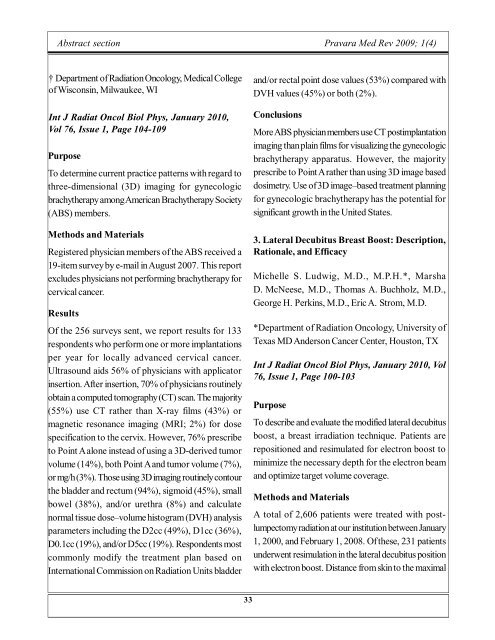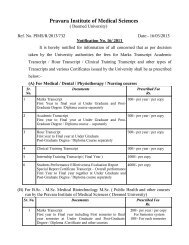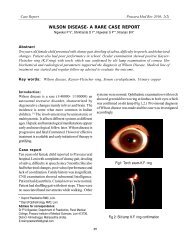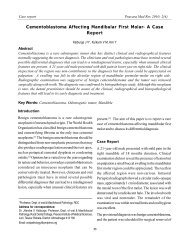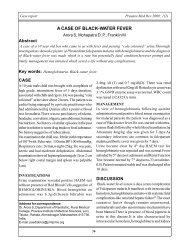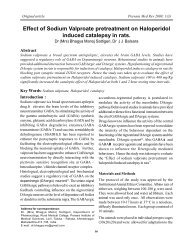ABSTRACT SECTION - Pravara Institute of Medical Sciences
ABSTRACT SECTION - Pravara Institute of Medical Sciences
ABSTRACT SECTION - Pravara Institute of Medical Sciences
Create successful ePaper yourself
Turn your PDF publications into a flip-book with our unique Google optimized e-Paper software.
Abstract section <strong>Pravara</strong> Med Rev 2009; 1(4)<br />
† Department <strong>of</strong> Radiation Oncology, <strong>Medical</strong> College<br />
<strong>of</strong> Wisconsin, Milwaukee, WI<br />
Int J Radiat Oncol Biol Phys, January 2010,<br />
Vol 76, Issue 1, Page 104-109<br />
Purpose<br />
To determine current practice patterns with regard to<br />
three-dimensional (3D) imaging for gynecologic<br />
brachytherapy among American Brachytherapy Society<br />
(ABS) members.<br />
Methods and Materials<br />
Registered physician members <strong>of</strong> the ABS received a<br />
19-item survey by e-mail in August 2007. This report<br />
excludes physicians not performing brachytherapy for<br />
cervical cancer.<br />
Results<br />
Of the 256 surveys sent, we report results for 133<br />
respondents who perform one or more implantations<br />
per year for locally advanced cervical cancer.<br />
Ultrasound aids 56% <strong>of</strong> physicians with applicator<br />
insertion. After insertion, 70% <strong>of</strong> physicians routinely<br />
obtain a computed tomography (CT) scan. The majority<br />
(55%) use CT rather than X-ray films (43%) or<br />
magnetic resonance imaging (MRI; 2%) for dose<br />
specification to the cervix. However, 76% prescribe<br />
to Point A alone instead <strong>of</strong> using a 3D-derived tumor<br />
volume (14%), both Point A and tumor volume (7%),<br />
or mg/h (3%). Those using 3D imaging routinely contour<br />
the bladder and rectum (94%), sigmoid (45%), small<br />
bowel (38%), and/or urethra (8%) and calculate<br />
normal tissue dose–volume histogram (DVH) analysis<br />
parameters including the D2cc (49%), D1cc (36%),<br />
D0.1cc (19%), and/or D5cc (19%). Respondents most<br />
commonly modify the treatment plan based on<br />
International Commission on Radiation Units bladder<br />
and/or rectal point dose values (53%) compared with<br />
DVH values (45%) or both (2%).<br />
Conclusions<br />
More ABS physician members use CT postimplantation<br />
imaging than plain films for visualizing the gynecologic<br />
brachytherapy apparatus. However, the majority<br />
prescribe to Point A rather than using 3D image based<br />
dosimetry. Use <strong>of</strong> 3D image–based treatment planning<br />
for gynecologic brachytherapy has the potential for<br />
significant growth in the United States.<br />
3. Lateral Decubitus Breast Boost: Description,<br />
Rationale, and Efficacy<br />
Michelle S. Ludwig, M.D., M.P.H.*, Marsha<br />
D. McNeese, M.D., Thomas A. Buchholz, M.D.,<br />
George H. Perkins, M.D., Eric A. Strom, M.D.<br />
*Department <strong>of</strong> Radiation Oncology, University <strong>of</strong><br />
Texas MD Anderson Cancer Center, Houston, TX<br />
Int J Radiat Oncol Biol Phys, January 2010, Vol<br />
76, Issue 1, Page 100-103<br />
Purpose<br />
To describe and evaluate the modified lateral decubitus<br />
boost, a breast irradiation technique. Patients are<br />
repositioned and resimulated for electron boost to<br />
minimize the necessary depth for the electron beam<br />
and optimize target volume coverage.<br />
Methods and Materials<br />
A total <strong>of</strong> 2,606 patients were treated with postlumpectomy<br />
radiation at our institution between January<br />
1, 2000, and February 1, 2008. Of these, 231 patients<br />
underwent resimulation in the lateral decubitus position<br />
with electron boost. Distance from skin to the maximal<br />
33


